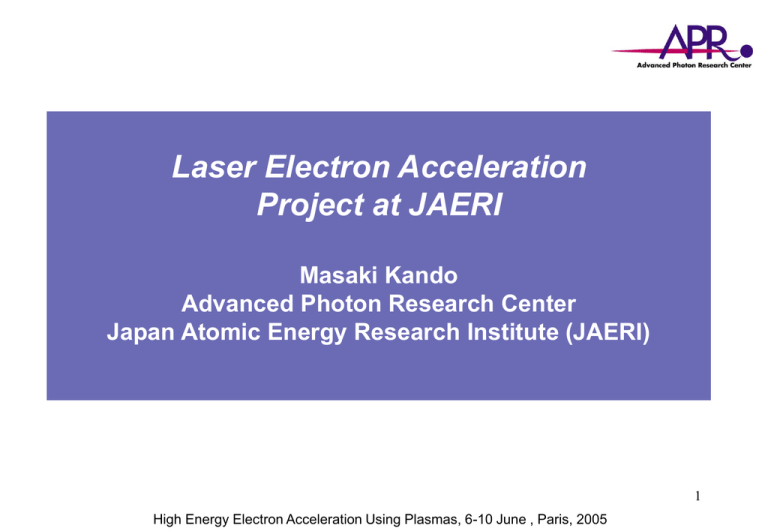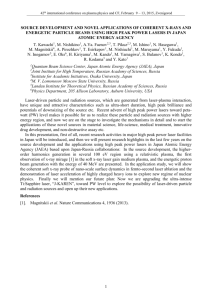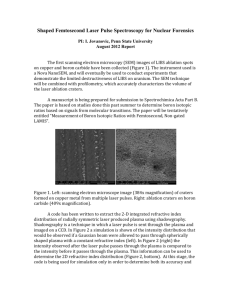High energy, high quality laser-plasma particle accelerator
advertisement

Laser Electron Acceleration Project at JAERI Masaki Kando Advanced Photon Research Center Japan Atomic Energy Research Institute (JAERI) 1 High Energy Electron Acceleration Using Plasmas, 6-10 June , Paris, 2005 Collaborators A. Yamazaki1,2), H. Kotaki1), S. Kondo1), T. Homma1), S. Kanazawa1), K. Nakajima1,3), L.M. Chen1), J. Ma1), H. Kiriyama1), Y. Akahane1), M. Mori1), Y. Hayashi1), Y. Nakai1), Y. Yamamoto1), K. Tsuji1), T. Shimomura1) , K. Yamakawa1) , J. Koga1), T. Hosokai4), A. Zhidkov4), K. Kinoshita4), M. Uesaka4), S. V. Bulanov1), T. Esirkepov1), M. Yamagiwa1), T. Kimura1), T. Tajima1) and International Experimental Taskforce (IET) members 1) APRC, JAERI 2) Kyoto University 3) High Energy Accelerator Research Organization (KEK) 4) The University of Tokyo 2 Table of Contents 1. Introduction 2. Theoretical work on Beam Quality 3. Our Approach to Good quality beams 1. High power laser :Bubble/Blow-out regime 2. Moderate power laser: Gas density control 4. Summary 3 Introduction JAERI Laser Electron Acceleration Project(2005-2009) • Demonstration of 1GeV Acceleration Bubble/blow-out, Fast-Z pinch capillary waveguide,.. • High quality beam production • Application - keV X-ray source (compact) We plan to use wakefield as an undulator - Pump-probe experiment (Ultrafast science) 4 Route to quasi-monoenergetic electrons • Bubble regime J. Faure et al., Nature 431 (2004) Blow-out regime W. Lu et al., This Workshop Scaling laws High peak power is required • Length matching L=Ldp (L=n Ldp n:integer is ok?) S. P. D. Mangles et al., Nature 431, 535 (2004) C. G. R. Geddes et al., Nature 431, 538 (2004) Not so high peak power is required Energy of quasi-monoenergetic peak (MeV) S. Gordienko & A. Pukhov, Phys. Plasmas 12, 043109 (2005) 1000 Experiments RAL (12TW/40fs) LOA (30TW/33fs) LBNL (9TW/55fs) AIST (2TW/50fs) JAERI/CRIEPI (5.5TW/70fs) 100 10 A. Yamazaki et al., submitted to PoP 1 1018 1019 1020 1021 Plasma density (cm-3) E. Miura et al., J. Plasma Fusion Res. 81 255-260 (2005) 5 Energy spectrum of accelerated electrons 1D Hamiltonian, Motion in 1st wake-period S.V. Bulanov et al., appeared in Phys. 6 Plasma, soon Energy spectrum of fast electrons 7 Energy spectrum of fast electrons 8 Transverse emittance 9 Transverse emittance 10 Transverse emittance 11 Near-Term Experiment at JAERI Long-Focus experiment • Peak power • Pulse duration • Focal length • Spot radius,w0 • Contrast • Peak intensity • Plasma density • Target • length > 50 TW 23 fs 775 mm / 450mm ~16µm / ~9 µm 10-6 6.2x1018 W/cm2 a0=1.7 at 25TW 2.0x1019 W/cm2 a0=3.0 at 25TW 3x1018-1x1020 cm-3 He-gas-jet 1.3-10 mm (slit length) Goal: Quasi-mono energetic electrons ‘Bubble /Blow-out regime’ Test of non-uniform plasma density Betatron X-ray measurement 12 Near-Term Experiment - Diagnosis • Electron – Charge – Energy magnet size 10cmx10cm Current Transformer Compact spectrometer w/Scintillating screen – High energy detection: Sampling calorimeter – Pulse duration • Bolometer (THz detection), Single-shot meas. by polychromator • • Plasma – Channeling Schlieren/shadowgraphy/ Interferometry X-ray – Energy Ross filter and Photon counting on CCD – Angular distribution Rail system & CCD and/or NaI 13 Experimental setup We are installing a new big target chamber OAP Test With He-Ne laser Almost perfect QuickTimeý Dz TIFFÅiLZWÅj êLí£ÉvÉçÉOÉâÉÄ Ç™Ç±ÇÃÉsÉNÉ`ÉÉǾå©ÇÈǞǽDžÇÕïKóvÇ­Ç• ÅB 14 2D PIC Simulations Although 2D simulation underestimates the maximum energy when self-focusing happens, qualitative estimation is valid. Uniform plasma a0=1.7 T=23 fs, sx=16µm Ne=3x1018 cm-3 Ne=1.7x1019 cm-3 15 2D PIC Simulations Parabolic- realistic distribution Sharp-density transition a0=1.7 T=23 fs, sx=16µm Ne=1.7x1019 - 8.5x1018cm-3 Ne=1.7x1019 cm-3 Narrow 16 Schedule 2005 Laser maintenance 4 5 6 7 8 9 10 11 12 Oscillator replacement/ Regen realignment Power Amp. YAG replacement Target Chamber New big chamber installation Optics adjustment Spot, Pulse duration check Experiment Shots (Electron/Ion) 17 Sharp density transition enhances injection No energetic electrons in homogenous plasma L=2µm 2.1x1019 cm-3 ne a0=1.3 t=17fs S. V. Bulanov et al., Phys.Rev.E 58, R5257 (1998) H. Suk et al., Phys. Rev. Lett 8, 1011 (2001) T. Hosokai et al., Phys. Rev. E 67, 036407 (2003) P. Tomassini et al., Phys. Rev. ST 6, 121301 (2003) Quasi-monoenergetic structure is formed if the length is appropriate. 1.1x1019 cm-3 P. Tomassini et al., Phys. Rev. ST 6, 121301 (2003) 18 U. Tokyo Artificial prepulse & High contrast Demonstration has been done Next step: controllability & stability Artificial prepulse In the compressor chamber, we will install optics to produce prepulse Uncompressed Laser Main pulse ~ 40 fs Artificial prepulse, ~ns Hydrodynamic code T. Hosokai et al., PRE 2003 High Contrast(better than 10-7) •Fast Pockels Cell •Frequency doubling 19 Control of gas-jet density • Compression1 Supersonic by shock-waves gas layer Controlling a curvature of the wall makes it possible High-density gas foil 2 3 Shockwaves from nozzle wall 6 1019 2 Z=4.6 mm 305ch 5 1019 4 1019 Gas density (cm-3) z y x 4 .0 m m 3 1019 2 1019 1 1019 3 0 100 2 1 -1 1019 -4 -3 -2 -1 0 1 2 3 4 X (mm) L~100 µm ~ spatial resolution 4 .0 m m 1 .2 6 m m Better measurement and Wall shape optimization are required 20 Preliminary test with density control In case of short-focal length, the upramp region destroys laser focusing To avoid ‘up-ramp’ density profile Solution1 : Gas-Cell + Supersonic gas-jet Shadow FocusPoint Plasma Channel He Me=5 Small aperture Exit aperture (x10-2) Lavar type Wall shape 1.0 2.0 M. Uesaka Lab. U. Tokyo 3.0 This configuration will be tested Solution2 Use longer focal length 21 Summary • Theoretical investigation of energy distribution is performed, and qualitatively reproduce experimental data. • Parameter survey will be done around ‘Bubble / Blow-out regime/’ with JAERI 100 TW, 23 fs laser. – Laser and target chamber improvement is under way. • Control of gas-distribution and prepulse are important for electron acceleration. – We are developing Gas-jet-nozzle in order to control particle injection and acceleration for relatively small lasers. 22






